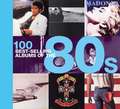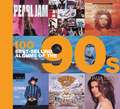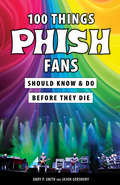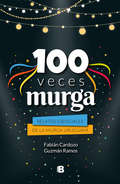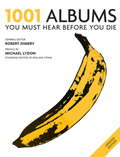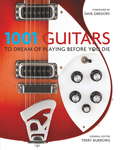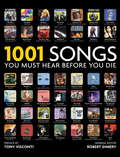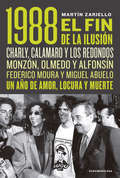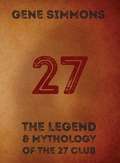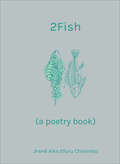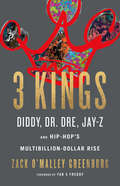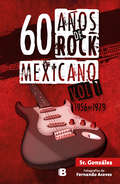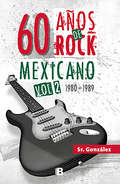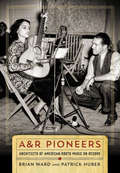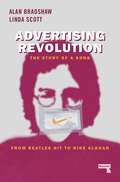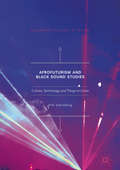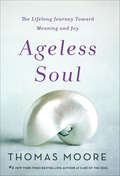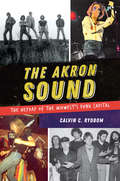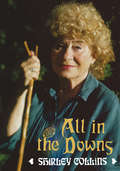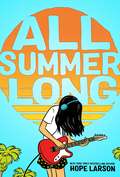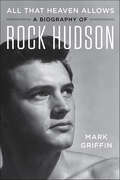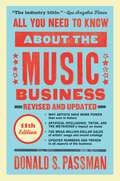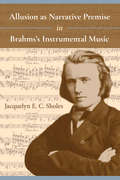- Table View
- List View
100 Best-selling Albums of the 80s
by Peter Dodd Justin Cawthorne Chris Barrett Dan AutyA totally righteous collection of tunes!From hair metal to the King of Pop, these 100 best-selling albums made up the soundtrack of the '80s. The wild success of artists Madonna, Michael Jackson, Van Halen, and Prince are chronicled here, along with more mellow musicians such as John Mellencamp, Phil Collins, Lionel Richie, and Huey Lewis. Metal heads will also appreciate entries from Def Leppard, Metallica, Guns ’n’ Roses, Quiet Riot, and more. Each listing features the full-color original sleeve artwork, and is packed with information about the musician lineup, track listings, and number-one singles that resulted. Return to the footloose years of the 1980s!
100 Best-selling Albums of the 90s
by Peter Dodd Justin Cawthorne Chris Barrett Dan AutyFind your nirvana in this list of best-selling albums of the 1990s.The music scene got a bit grungier in the 1990s, but these Top 100 albums wrapped up the 20th century with a big finish. From the Dixie Chicks and Spice Girls to Sheryl Crow and Alanis Morissette, women stepped up during this decade to make sure their voices were heard. Nirvana, Matchbox 20, Green Day, and the Backstreet Boys all had vastly different sounds, but were united in their popularity. Each listing features the full-color original sleeve artwork, and is packed with information about the musician lineup, track listings, and number one-singles that resulted.
100 Things Phish Fans Should Know & Do Before They Die (100 Things...Fans Should Know)
by Jason Gershuny Andy Smith Mike GreenhausFew music groups have been able to sustain a fan base as passionate and dedicated as that of Phish, and this entertaining guide rewards those fans with everything they need to know about the band in a one-of-a-kind format. Packed with history, trivia, lists, little-known facts, and must-do adventures that every Phish fan should undertake, it ranks each item from one to 100, providing an indispensable, engaging road map for devotees old and new.
100 veces murga: Relatos escenciales de la murga uruguaya
by Fabián Cardozo Guzmán RamosLa historia de la murga uruguaya contada por sus protagonistas a través de 100 anécdotas fundamentales. La historia de la murga uruguaya contada por sus protagonistas en 100 anécdotas: este fue el proyecto que los periodistas Fabián Cardozo y Guzmán Ramos se plantearon y realizaron.Esta obra es un coro de murga contando su propia historia. <P><P>Los máximos referentes del género cantan las historias más divertidas, tristes y emocionantes que dieron y dan vida a uno de los fenómenos culturales de nuestro país.El lector podrá disfrutar y sentirse parte de esta historia a través de la lectura, pero también a través de videos incluidos en códigos QR donde podrá ver a los protagonistas narrando las historias. <P><P>En las páginas de 100 veces murga. Relatos esenciales de la murga uruguaya conocerá desde los orígenes del género, las distintas corrientes, quiénes son sus principales figuras y personajes, los entretelones del concurso oficial y sus polémicas, la llegada de " la murga joven " al carnaval y cómo cambió el género en los últimos tiempos.Es hora de sentarse, pintarse la cara y comenzar a leer esta historia, una historia del Uruguay y su gente.
1001 Albums You Must Hear Before You Die: You Must Hear Before You Die (1001)
by Robert DimeryWhat did Time magazine consider the twentieth-century's greatest album? Which anthem by Prince was an attempt to emulate Bob Seger? And what links Count Basie and Batman?If you thought you knew your music, then think again. 1001Albums You Must Hear Before You Die, is totally revised and fully updated for 2013, and is the definitive guide to accompany your interest in music. Written by top UK and US music journalists, and includes a preface by Michael Lydon, the founding editor of the Rolling Stone magazine. It celebrates the great and ground-breaking albums throughout the eras - from the genesis of Fifties rock 'n' roll to the technological and electronic innovations of the 2000s.Each entry includes key tracks and explains exactly why each of these albums deserved to be included in the list, offering an insight into the process of their creation, development, and success. With albums from Elvis Presley, Frank Sinatra, Miles Davis, The Rolling Stones, Bob Dylan, The Sex Pistols, ACDC, Ray Price, the Beach Boys, Sonic Youth, P J Harvey, Jack White, Green Day, Christina Aguilera, and the latest from David Bowie, as well as new cutting-edge entries such as Kendrick Lamar and Django Django, 1001 Albums You Must Hear Before You Die covers all the works that have formed part of the soundtracks to all our lives, at one point or another.Illustrated with more than 900 iconic images of album covers, bands and artists, as well as photographs from many legendary gigs, 1001 Albums You Must Hear Before You Die, covers from the 1950s to the present and is the single most comprehensive list of music that changed the world, an absolute must-have for all the musically inspired.
1001 Guitars to Dream of Playing Before You Die (1001)
by Terry BurrowsFind out why Chet Atkins had a Gretsch guitar named after him, why The Who's John Entwistle called his favourite guitar "Frankenstein", and how John Lennon elevated the Rickenbacker 325 to one of the most desirable guitar brands of the 1960's.1001 Guitars to Dream of Playing Before Your Die showcases the greatest instruments from across the globe: some are of historical or cultural significance and some were made famous by well-known musicians; others are included as examples of technological breakthroughs, innovative design or extraordinary sound quality. From the earliest models produced by Belchior Dias in the sixteenth century to the latest Gibson "Robot" series of guitars with computer-controlled self-tuning capabilities and onboard sound-processing features, 1001 Guitars to Dream of Playing Before Your Die tells the fascinating stories behind the creation of each one.All the classic names are here - Fender, Roland, Martin, Gretsch and Rickenbacker - as well as important Japanise brands, such as Ibanez, Yamaha and Teisco; European classics of the 1960's including Burns, Hagstrom, Eko and Hofner; obscure models from behind the "Iron Curtain", such as Defil, Aelita, Resonet and Musima; and present-day oil-can guitars built in South Africa. Never before have so many guitars been profiled within a single illustrated volume.A striking colour photograph of each guitar is accompanied by specification details and illuminating text that traces the guitar's history and reveals which famous musicians like to play the instrument and on what albums it can be heard. Contents includes... IntroductionPre -1930s1930 - 1949 1950s1960s1970s1980s1990s2000s
1001 Songs: You Must Hear Before You Die (1001)
by Robert DimeryAn inspiring selection of the most iconic songs ever released, covering all the genres for nearly a century of memorable music.
1988. El fin de la ilusión: Charly, Calamaro y los Redondos; Monzón, Olmedo, Asís y Alfonsín; Federico Moura y Miguel Abuelo. Un año de amor, locura y muerte.
by Martín ZarielloUna semblanza divertida y reflexiva sobre 1988, un año bisagra en el rock nacional y en la vida cultural, política y social del país. Martín Zariello pone su lupa pop en el paisaje agridulce de esa época. El año en que -recién acababa de irse de este mundo Luca- mueren Federico Moura y Miguel Abuelo, el primer gobierno del retorno democrático entra en crisis y con él, el sueño entero de una generación parece desvanecerse. Una semblanza divertida y reflexiva sobre 1988, un año bisagra en el rock nacional y en la vida cultural, política y social del país. Como un rompecabezas, piezas aparentemente inconexas con los rostros de Alfonsín, Charly García, Luis Alberto Spinetta, Carlos Monzón, Cerati, Los Redonditos, Fito Páez, Alberto Olmedo, Rico & Seineldín y hasta Ricardo Piglia y Jorge Asís forman la trama de un año que, a tres décadas, pide urgente una revisión que soslaye las trampas de la nostalgia. Martín Zariello pone su lupa pop en el paisaje agridulce de ese año bisagra. El año en que -recién acaba de morir Luca- mueren Federico Moura y Miguel Abuelo, el primer gobierno del retorno democrático entra en crisis y con él, el sueño entero de una generación parece desvanecerse. Los capítulos: Alfonsín Live on tour 88 - Maral 39 - Amnesty es un lugar del que nadie puede regresar - Hipótesis alrededor de una canción de Cacho Castaña - Argentinos pero simpáticos - Pelusón of Foucault - Todos los femicidios, el femicidio - Sida intelectual - Te tendrás que cuidar - Los años del "rock pobre" -El amor antes del amor - Spaguetti del rock - La vanguardia era así - El futuro ya llegó
27: The Legend And Mythology Of The 27 Club
by Gene SimmonsThe summer of 1969 was a momentous one in modern history. It was a season punctuated with change. Apollo 11 landed on the moon, thousands of young fans flocked to rock &‘n&’ roll festivals like Woodstock and the controversial Altamont Freeway concert, the Manson Family cult were on a high-profile killing spree, and the first uprisings that would become the Stonewall Riots began. It was an electric summer of violent endings, new beginnings, and social unrest.It was also the summer that a myth was born–beginning with the tragic, untimely death of Rolling Stones founder, Brian Jones. The world soon lost two more huge music stars: Janis Joplin and Jimi Hendrix. Not only did losing these three beacons of music culture seem to signal the end of a musical era, it also felt like a foreboding sign; they had all died at exactly the same age. All three had lost their lives at the pinnacle of their creative output, and all three were exactly 27 years old.People have speculated that there could be a dastardly lineage, from the poisoning of blues pioneer Robert Johnson in 1938, through these icons of the 60s, and more recently to rebel chanteuse Amy Winehouse&’s death from alcohol poisoning in 2011. Could it be a twisted fate that the world&’s very best creative souls come to early, often violent, deaths at just 27 years old? Over time, this idea began to be known as, &“the 27 club,&” and it has persisted in the public imagination.In 27: The Legend and Mythology of the 27 Club, rock &‘n&’ roll icon Gene Simmons takes a deep dive into the life stories of these legendary figures, without giving credence to the romanticized idea that being in the &“club&” is somehow a perverse privilege. Simmons wills us to acknowledge the extraordinary lives, not the sensational deaths, of the musicians and artists who left an indelible mark on the world.
2Fish: (a poetry book)
by Jhené Aiko ChilomboGrammy nominated singer/songwriter Jhené Aiko Efuru Chilombo has developed and refined a method of emoting through writing.2Fish is a collection of intimate poems (and a few short stories) written by Chilombo from adolescence to adulthood, in no particular order. The book details Chilombo's thoughts in their most raw and honest form taken directly from a collection of notebooks she has kept since age 12.
3 Kings: Diddy, Dr. Dre, Jay-Z, and Hip-Hop's Multibillion-Dollar Rise
by Zack O'Malley Greenburg<P> Tracing the careers of hip-hop's three most dynamic stars, this deeply reported history brilliantly examines the entrepreneurial genius of the first musician tycoons: Diddy, Dr. Dre, and Jay-ZBeing successful musicians was simply never enough for the three kings of hip-hop. Diddy, Dr. Dre, and Jay-Z lifted themselves from childhood adversity into tycoon territory, amassing levels of fame and wealth that not only outshone all other contemporary hip-hop artists, but with a combined net worth of well over $2 billion made them the three richest American musicians, period. <P>Yet their fortunes have little to do with selling their own albums: between Diddy's Ciroc vodka, Dre's $3 billion sale of his Beats headphones to Apple, and Jay-Z's Tidal streaming service and other assets, these artists have transcended pop music fame to become lifestyle icons and moguls.Hip-hop is no longer just a musical genre; it's become a way of life that encompasses fashion, film, food, drink, sports, electronics and more - one that has opened new paths to profit and to critical and commercial acclaim. Thanks in large part to the Three Kings-who all started their own record labels and released classic albums before moving on to become multifaceted businessmen-hip-hop has been transformed from a genre spawned in poverty into a truly global multibillion-dollar industry. <P>These men are the modern embodiment of the American Dream, but their stories as great thinkers and entrepreneurs have yet to be told in full. Based on a decade of reporting, and interviews with more than 100 sources including hip-hop pioneers Russell Simmons and Fab 5 Freddy; new-breed executives like former Def Jam chief Kevin Liles and venture capitalist Troy Carter; and stars from Swizz Beatz to Shaquille O'Neal, 3 Kings tells the fascinating story of the rise and rise of the three most influential musicians in America.
60 años de rock mexicano: Vol. 1: 1956-1979
by Rafael González VillegasEl rock es un producto de su tiempo, es una necedad arraigada hasta el tuétano de quien lo goza. El rock es un adolescente cuyo espíritu se niega a envejecer. Se debate entre la forma y el contenido, entre el goce y la conciencia. Es como una vedete que se regodea ante el espejo y luego, en soledad, se pregunta quién es. El rock mexicano cumple 60 años, y Rafael González narra esta leyenda construyendo una máquina del tiempo llena de nostalgia y canciones entrañables, acompañadas por las fotografías de Fernando Aceves. Este es el primero de dos volúmenes que narran la historia del movimiento roquero nacional. Aquí se cuentan tres décadas míticas: los años cincuenta, los vertiginosos sesenta y el tropel de los setenta.
60 años de rock mexicano. Vol. 2: 1980-1989
by Sr. GonzálezEl rock es un producto de su tiempo, es una necedad arraigada hasta el tuétano de quien lo goza. En este segundo volumen, el Sr. González nos entrega un retrato excepcional, que proviene tanto de su experiencia como músico como de una extensa y sesuda investigación, de la escena del rock mexicano en la que quizá ha sido su década más fructífera y apasionante: la década de los ochenta. Durante esos geniales y convulsos años, México atravesó por cambios profundos que también dejaron su huella en la música. Fueron tiempos de apertura en los que el rock nacional forjó una voz y ritmo propios; la esencia de aquella música rebelde y adolescente que llegó a México en 1956 encontró en los ochenta su carta de naturalización. A esta época corresponden músicos y bandas icónicos como Rockdrigo González, El Tri, Botellita de Jerez, Maldita Vecindad y los Hijos del Quinto Patio, Caifanes, Café Tacvba, Fobia, entre muchas otras agrupaciones que cantaron con fuerza sus letras y tocaron sus guitarras con estruendo. A todas ellas y más, este libro les dedica una breve y apasionante crónica junto con un análisis musical
A&R Pioneers: Architects of American Roots Music on Record (Co-published with the Country Music Foundation Press)
by Brian Ward Patrick HuberA&R Pioneers offers the first comprehensive account of the diverse group of men and women who pioneered artists-and-repertoire (A&R) work in the early US recording industry. In the process, they helped create much of what we now think of as American roots music. Resourceful, innovative, and, at times, shockingly unscrupulous, they scouted and signed many of the singers and musicians who came to define American roots music between the two world wars. They also shaped the repertoires and musical styles of their discoveries, supervised recording sessions, and then devised marketing campaigns to sell the resulting records. By World War II, they had helped redefine the canons of American popular music and established the basic structure and practices of the modern recording industry. Moreover, though their musical interests, talents, and sensibilities varied enormously, these A&R pioneers created the template for the job that would subsequently become known as "record producer."Without Ralph Peer, Art Satherley, Frank Walker, Polk C. Brockman, Eli Oberstein, Don Law, Lester Melrose, J. Mayo Williams, John Hammond, Helen Oakley Dance, and a whole army of lesser known but often hugely influential A&R representatives, the music of Bessie Smith and Bob Wills, of the Carter Family and Count Basie, of Robert Johnson and Jimmie Rodgers may never have found its way onto commercial records and into the heart of America's musical heritage. This is their story.
A&R Pioneers: Architects of American Roots Music on Record (Co-published with the Country Music Foundation Press)
by Brian Ward Patrick HuberAssociation for Recorded Sound Collections Certificate of Merit for the Best Historical Research in Recorded Roots or World Music, 2019A&R Pioneers offers the first comprehensive account of the diverse group of men and women who pioneered artists-and-repertoire (A&R) work in the early US recording industry. In the process, they helped create much of what we now think of as American roots music. Resourceful, innovative, and, at times, shockingly unscrupulous, they scouted and signed many of the singers and musicians who came to define American roots music between the two world wars. They also shaped the repertoires and musical styles of their discoveries, supervised recording sessions, and then devised marketing campaigns to sell the resulting records. By World War II, they had helped redefine the canons of American popular music and established the basic structure and practices of the modern recording industry. Moreover, though their musical interests, talents, and sensibilities varied enormously, these A&R pioneers created the template for the job that would subsequently become known as "record producer." Without Ralph Peer, Art Satherley, Frank Walker, Polk C. Brockman, Eli Oberstein, Don Law, Lester Melrose, J. Mayo Williams, John Hammond, Helen Oakley Dance, and a whole army of lesser known but often hugely influential A&R representatives, the music of Bessie Smith and Bob Wills, of the Carter Family and Count Basie, of Robert Johnson and Jimmie Rodgers may never have found its way onto commercial records and into the heart of America's musical heritage. This is their story.
Advertising Revolution: The Story of a Song, from Beatles Hit to Nike Slogan
by Alan Bradshaw Linda ScottThe story of "Revolution" by the Beatles, from its origin as a protest song of the 1960s, to it becoming the musical backdrop for one of the most famous, influential, and controversial adverts of all time.In 1987, Nike released their new sixty-second commercial for Air shoes—and changed the face of the advertising industry. Set to the song “Revolution” by the Beatles, the commercial was the first and only advert ever to feature an original recording of the FaUb Four. It sparked a chain of events that would transform the art of branding, the sanctity of pop music, the perception of advertisers in popular culture, and John Lennon’s place in the leftist imagination.Advertising Revolution traces the song “Revolution” from its origins in the social turmoil of the Sixties, through its controversial use in the Nike ad, to its status today as a right-wing anthem and part of Donald Trump’s campaign set list. Along the way, the book unfolds the story of how we came to think of Nike as the big bad wolf of soulless corporations, and how the Beatles got their name as the quintessential musicians of independent integrity. To what degree are each of these reputations deserved? How ruthlessly cynical was the process behind the Nike ad? And how wholesomely uncommercial was John Lennon’s writing of the song?Throughout the book, Alan Bradshaw and Linda Scott complicate our notions of commercialism and fandom, making the case for a reading of advertisements that takes into account the many overlapping intentions behind what we see onscreen. Challenging the narratives of the evil-genius ad conglomerate and the pure-intentioned artist, they argue that we can only begin to read adverts productively when we strip away the industry’s mysticism and approach advertisers and artists alike as real, flawed, differentiated human beings.
Afrofuturism and Black Sound Studies: Culture, Technology, and Things to Come (Palgrave Studies in Sound)
by Erik SteinskogThis book interrogates the meeting point between Afrofuturism and Black Sound Studies. Whereas Afrofuturism is often understood primarily in relation to science fiction and speculative fiction, it can also be examined from a sonic perspective. The sounds of Afrofuturism are deeply embedded in the speculative - demonstrated in mythmaking - in frameworks for songs and compositions, in the personas of the artists, and in how the sounds are produced. In highlighting the place of music within the lived experiences of African Americans, the author analyses how the perspectives of Black Sound Studies complement and overlap with the discussion of sonic Afrofuturism. Focusing upon blackness, technology, and sound, this unique text offers key insights in how music partakes in imagining and constructing the future. This innovative volume will appeal to students and scholars of sound studies, musicology and African American studies.
Ageless Soul: The Lifelong Journey Toward Meaning and Joy
by Thomas MooreAgeless Soul will teach readers how to embrace the richness of experience and how to take life on, accept invitations to new vitality, and feel fulfilled as they get older.Thomas Moore is the renowned author of Care of the Soul, the classic #1 New York Times bestseller. In Ageless Soul, Moore reveals a fresh, optimistic, and rewarding path toward aging, one that need not be feared, but rather embraced and cherished. In Moore’s view, aging is the process by which one becomes a more distinctive, complex, fulfilled, loving, and connected person. Using examples from his practice as a psychotherapist and teacher who lectures widely on the soul of medicine and spirituality, Moore argues for a new vision of aging: as a dramatic series of initiations, rather than a diminishing experience, one that each of us has the tools—experience, maturity, fulfillment—to live out. Subjects include:*Why melancholy is a natural part of aging, and how to accept it, rather than confuse it with depression *The vital role of the elder and mentor in the lives of younger people*The many paths of spiritual growth and learning that open later in life*Sex and sensuality *Building new communities and leaving a legacy
The Akron Sound: The Heyday of the Midwest's Punk Capital
by Calvin C. RydbomMusic made in Akron symbolized an attitude more so than a singular sound. Crafted by kids hell-bent on not following their parents into the rubber plants, the music was an intentional antithesis of Top 40 radio. Call it punk or call it new wave, but in a short few years, major labels signed Chrissie Hynde, Devo, the Waitresses, Tin Huey, the Bizarros, the Rubber City Rebels and Rachel Sweet. They had their own bars, the Crypt and the Bank. They had their own label, Clone Records. They even had their own recording space, Bushflow Studios. London's Stiff Records released an Akron compilation album, and suddenly there were "Akron Nights" in London clubs and CBGB was waiving covers for people with Akron IDs. Author Calvin Rydbom of the "Akron Sound" Museum remembers that short time when the Rubber City was the place.
Alban Berg: A Research and Information Guide (Routledge Music Bibliographies #Vol. 38)
by Bryan R. SimmsAlban Berg: A Research and Information Guide, Third Edition is an annotated bibliography highlighting both the nature of primary sources related to the composer and the scope and significance of the secondary sources that deal with Berg, his compositions, and his influence as a composer. It is a reliable, complete, and useful resource and a starting point for anyone—performer, teacher, student, or scholar—wanting to learn about Berg’s life, works, and cultural milieu. The third edition has 162 additional citations since the publication of the second edition, many arising after the expiration of copyright of Berg’s musical and archival works 2005. Many important new, primary sources of information have appeared, most notably the letter exchanges with his wife, recently published in a three-volume critical edition (in German), as well as letter exchanges with Alma Mahler and Erich Kleiber, and later correspondences with Anton Webern. There has also been a notable increase in the availability of commercial video recordings of Berg's operas, Wozzeck and Lulu.
All in the Downs: Reflections on Life, Landscape, and Song (Strange Attractor Press Ser.)
by Shirley CollinsA memoir from one of Britain's legendary singers, folklorists, and music historians.A legendary singer, folklorist, and music historian, Shirley Collins has been an integral part of the folk-music revival for more than sixty years. In her new memoir, All in the Downs, Collins tells the story of that lifelong relationship with English folksong—a dedication to artistic integrity that has guided her through the triumphs and tragedies of her life. All in the Downs combines elements of memoir—from her working-class origins in wartime Hastings to the bright lights of the 1950s folk revival in London—alongside reflections on the role traditional music and the English landscape have played in shaping her vision. From formative field recordings made with Alan Lomax in the United States to the &“crowning glories&” recorded with her sister Dolly on the Sussex Downs, she writes of the obstacles that led to her withdrawal from the spotlight and the redemption of a new artistic flourishing that continues today with her unexpected return to recording in 2016. Through it all, Shirley Collins has been guided and supported by three vital and inseparable loves: traditional English song, the people and landscape of her native Sussex, and an unwavering sense of artistic integrity. All in the Downs pays tribute to these passions, and in doing so, illustrates a way of life as old as England, that has all but vanished from this land.Generously illustrated with rare archival material.
All Summer Long (Eagle Rock Series #1)
by Hope Larson*A Kirkus Reviews Best Book of 2018!*All Summer Long, a coming-of-age middle-grade graphic novel about summer and friendships, written and illustrated by the Eisner Award–winning and New York Times–bestselling Hope Larson. Thirteen-year-old Bina has a long summer ahead of her. She and her best friend, Austin, usually do everything together, but he's off to soccer camp for a month, and he's been acting kind of weird lately anyway. So it's up to Bina to see how much fun she can have on her own. At first it's a lot of guitar playing, boredom, and bad TV, but things look up when she finds an unlikely companion in Austin's older sister, who enjoys music just as much as Bina. But then Austin comes home from camp, and he's acting even weirder than when he left. How Bina and Austin rise above their growing pains and reestablish their friendship and respect for their differences makes for a touching and funny coming-of-age story.
All That Heaven Allows: A Biography of Rock Hudson
by Mark GriffinThe inspiration for the HBO® Original Documentary, Rock Hudson: All that Heaven Allowed, airing June 28!The definitive biography of the deeply complex and widely misunderstood matinee idol of Hollywood’s Golden Age.“Mark Griffin paints a vivid portrait of a man who lived a double life in order to maintain his status as a movie star. Griffin’s sources are candid but credible, which makes the book a real page-turner. I came away admiring Hudson all the more, and feeling sad for the secret existence that Hollywood demanded of its leading men in the 1950s and 60s.” — Leonard Maltin, author of Hooked on Hollywood: Discoveries from a Lifetime of Film FandomDevastatingly handsome, broad-shouldered and clean-cut, Rock Hudson was the ultimate movie star. The embodiment of romantic masculinity in American film throughout the ‘50s and ‘60s, he reigned supreme as the king of Hollywood.As an Oscar-nominated leading man, Hudson won acclaim for his performances in glossy melodramas (Magnificent Obsession), western epics (Giant) and blockbuster bedroom farces (Pillow Talk). In the ‘70s and ‘80s, Hudson successfully transitioned to television; his long-running series McMillan & Wife and a recurring role on Dynasty introduced him to a whole new generation of fans.The icon worshipped by moviegoers and beloved by his colleagues appeared to have it all. Yet beneath the suave and commanding star persona, there was an insecure, deeply conflicted, and all too vulnerable human being. Growing up poor in Winnetka, Illinois, Hudson was abandoned by his biological father, abused by an alcoholic stepfather, and controlled by his domineering mother.Despite seemingly insurmountable obstacles, Hudson was determined to become an actor at all costs. After signing with the powerful but predatory agent Henry Willson, the young hopeful was transformed from a clumsy, tongue-tied truck driver into Universal Studio’s resident Adonis. In a more conservative era, Hudson’s wholesome, straight arrow screen image was at odds with his closeted homosexuality.As a result of his gay relationships and clandestine affairs, Hudson was continually threatened with public exposure, not only by scandal sheets like Confidential but by a number of his own partners. For years, Hudson dodged questions concerning his private life, but in 1985 the public learned that the actor was battling AIDS. The disclosure that such a revered public figure had contracted the illness focused worldwide attention on the epidemic.Drawing on more than 100 interviews with co-stars, family members and former companions, All That Heaven Allows delivers a complete and nuanced portrait of one of the most fascinating stars in cinema history.Griffin provides new details concerning Hudson’s troubled relationships with wife Phyllis Gates and boyfriend Marc Christian. And here, for the first time, is an in-depth exploration of Hudson’s classic films, including Written on the Wind, A Farewell to Arms, and the cult favorite Seconds. With unprecedented access to private journals, personal correspondence, and production files, Griffin pays homage to the idol whose life and death had a lasting impact on American culture.
All You Need to Know About the Music Business: Eleventh Edition
by Donald S. PassmanDubbed &“the industry bible&” by the Los Angeles Times, All You Need to Know About the Music Business by veteran music lawyer Donald Passman is the go-to guide for everyone in the music business through ten editions, over thirty years, and over a half a million copies sold. Now with updates explaining why musicians have more power today than ever in history; discussion of the mega-million-dollar sales of artists&’ songs and record catalogs; how artist access to streaming media, and particularly TikTok, has completely reshaped the music business; the latest on music created by AI; and a full update of the latest numbers and trends.For more than thirty years, All You Need to Know About the Music Business has been universally regarded as the definitive guide to the music industry. Now in its eleventh edition, Passman leads novices and experts alike through what has been the most profound change in the music business since the days of wax cylinders and piano rolls: streaming. For the first time in history, music is no longer monetized by selling something—it&’s monetized by how many times a listener streams a song. And also, for the first time, artists can get their music to listeners without a record company gatekeeper, creating a new democracy for music. The &“industry bible&” (Los Angeles Times), now updated, is essential for anyone in the music business—musicians, songwriters, lawyers, agents, promoters, publishers, executives, and managers—and the definitive guide for anyone who wants to be in the business. So, whether you are—or aspire to be—in the music industry, veteran music lawyer Passman&’s comprehensive guide is an indispensable tool. He offers timely information about the latest trends, including the reasons why artists have more clout than ever in history, the massive influence of TikTok, the mega million dollar sales of artists&’ songs and record catalogs, music in Web3 and the Metaverse, music created by AI, and a full update of the latest numbers and practices.
Allusion as Narrative Premise in Brahms’s Instrumental Music (Musical Meaning and Interpretation)
by Jacquelyn E. SholesWho inspired Johannes Brahms in his art of writing music? In this book, Jacquelyn E. C. Sholes provides a fresh look at the ways in which Brahms employed musical references to works of earlier composers in his own instrumental music. By analyzing newly identified allusions alongside previously known musical references in works such as the B-Major Piano Trio, the D-Major Serenade, the First Piano Concerto, and the Fourth Symphony, among others, Sholes demonstrates how a historical reference in one movement of a work seems to resonate meaningfully, musically, and dramatically with material in other movements in ways not previously recognized. She highlights Brahms's ability to weave such references into broad, movement-spanning narratives, arguing that these narratives served as expressive outlets for his complicated, sometimes conflicted, attitudes toward the material to which he alludes. Ultimately, Brahms's music reveals both the inspiration and the burden that established masters such as Domenico Scarlatti, J. S. Bach, Haydn, Mozart, Schubert, Schumann, Wagner, and especially Beethoven represented for him as he struggled to emerge with his own artistic voice and to define and secure his unique position in music history.
